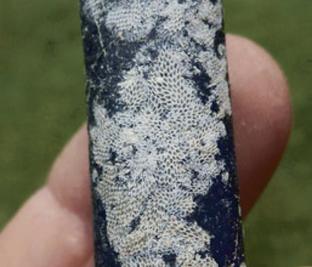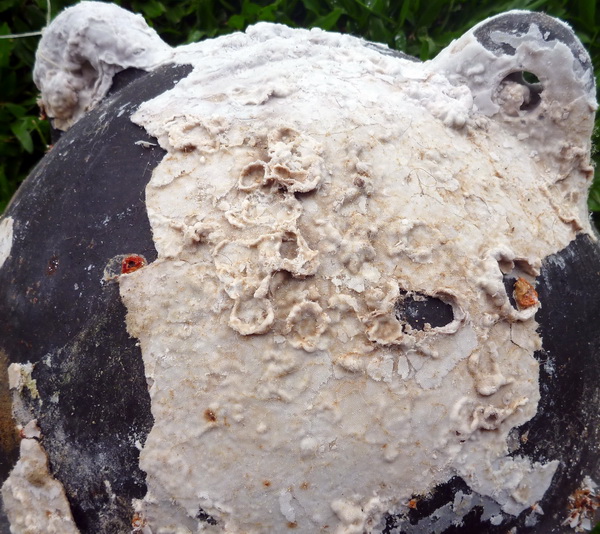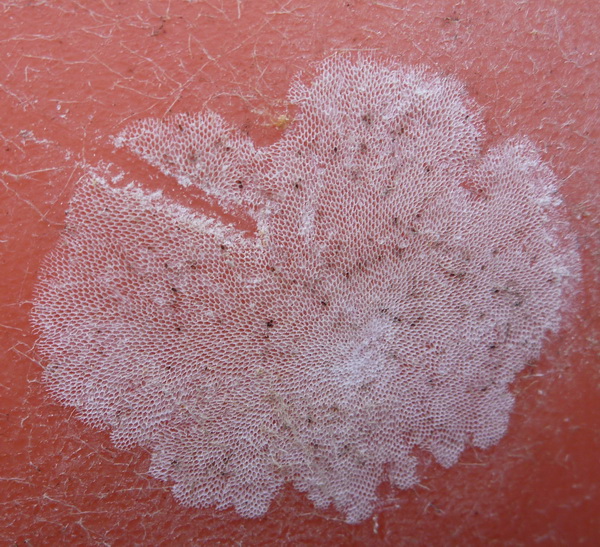Published in the Ocean Watch column, Honolulu Star-Advertiser © Susan Scott
May 2, 2011
During the recent marine debris conference in Honolulu, I overheard an artist explain to a student that coral grew on drifting plastic. The piece they were examining had a splotch of cementlike growth stuck to it. That white stuff, however, was not coral.
“Those are bryozoans,” I said.

©2011 Susan Scott
Bryozoans grow on nearly everything that floats in the open ocean.
As soon as I said it, I wished I hadn’t because the artist, of course, said, “What’s a bryozoan?” And I didn’t have a good answer.
Even as I write, with three zoology textbooks, a field guide and the Internet in front of me, I’m still struggling with how to describe the little creatures called bryozoans.
Part of the problem in describing these animals is the variety of forms and lifestyles they take. Bryozoans can be upright and branching, thin and encrusting, lacy and fragile, tangled and bushy. A few bryozoans walk on sand using rowing movements of whiplike appendages. A freshwater, jellylike species creeps over plants like a snail.
One form of bryozoan, though, is familiar to those of us who frequent Hawaii’s beaches: the white encrusting type the artist thought was coral. Bryozoan colonies grow in bumpy sheets on nearly everything that drifts in the open ocean, from fishing floats to driftwood to tiny pieces of plastic. These bryozoans attach themselves so firmly to surfaces below the waterline that it usually takes an overnight soaking in a bleach solution to get them off.

Coral was a reasonable guess for the artist discussing her marine debris art pieces because, like coral, bryozoans are colonial animals that make calcium carbonate skeletons connected to one another. Bryozoans do not, however, build on top of one another’s skeletons, like the reef-building corals.
Another similarity to corals is the crown of tentacles surrounding the mouth of each bryozoan body, which is usually about one-twenty-fifth of an inch or less wide. (If you look closely, you can make out the individual bodies with the naked eye.) Bryozoans’ tentacles (not visible) don’t sting like coral, but rather draw drifting food particles into the mouth with tiny beating hairs.
In corals each individual’s mouth also serves as its anus. A bryozoan, though, has an anus outside its ring of tentacles. Because having an anus is a step up in terms of evolution, bryozoans are considered more advanced than corals.

Bryozoans are a curse to boats and harbors because they glue themselves to hulls, piers and pilings. But even though they foul our vessels and scar our green glass balls, we shouldn’t wish bryozoans away. Researchers have extracted a substance called bryostatin from the animals that has strong anti-cancer properties. Bryostatin also shows promise for not only treating Alzheimer’s disease symptoms, but for repairing its underlying causes.
About 50 kinds of bryozoans inhabit fresh water, but most of the world’s 5,000 species live in tropical oceans. Hawaii’s waters host about 200 species.
Bryozoans have several common names. Moss animal is the one I see most often, but one biology dictionary calls them sea mats. An Internet site suggests (jokingly) that these weird and wondrous animals are mutants from outer space.
I’ll go with the descriptive name, sea mat. It gives me an answer to “What’s a bryozoan?” besides “Um.”